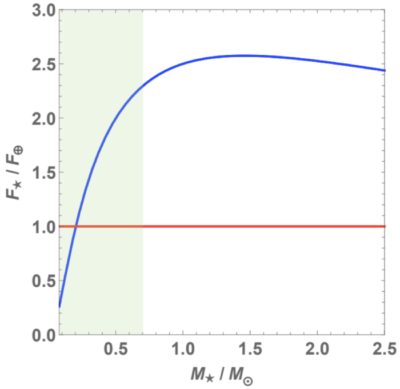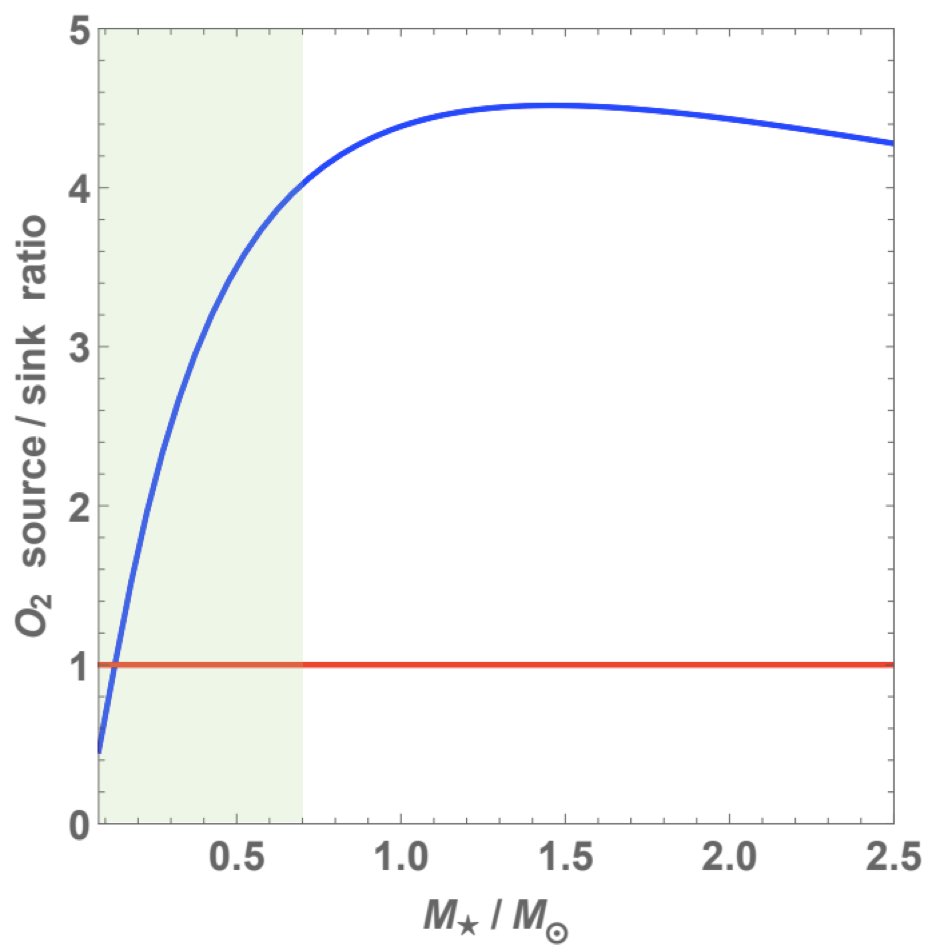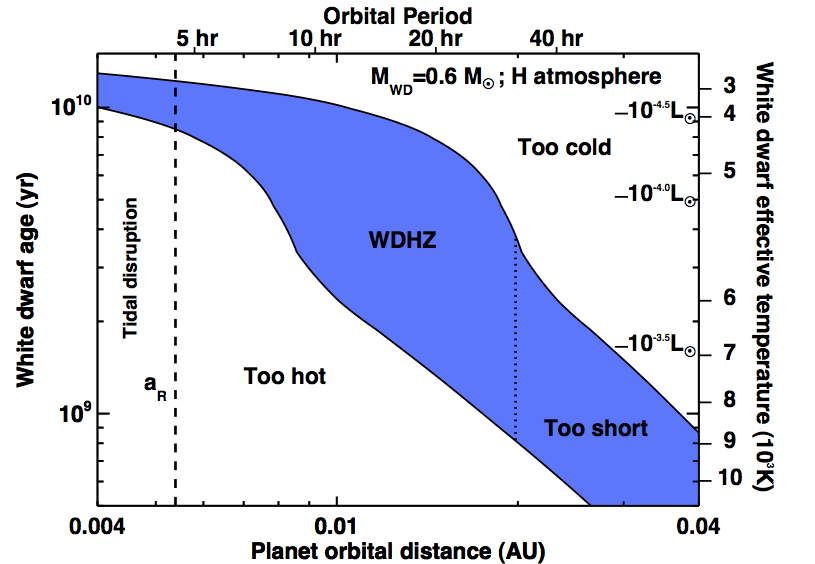Title: Photosynthesis on habitable planets around low-mass stars
Authors: Manasvi Lingam and Abraham Loeb
First Author’s Institution: Institute for Theory and Computation, Harvard University, USA and Harvard-Smithsonian Centre for Astrophysics, USA
Status: Accepted for publication in MNRAS, open access on arXiv
Photosynthesis is a key driving force for life on Earth. Plants absorb carbon dioxide, water, and energy from the Sun, convert this into sugar, and release oxygen into the atmosphere. This deceptively simple process dominates the ‘net primary productivity’ (NPP) of Earth, or the rate at which biomass energy is stored and made available to other organisms- in other words, photosynthesis provides the main source of accessible energy for all lifeforms which can’t produce their own (like us)! Considering photosynthesis is such a crucial process on our own planet, it stands to reason that it’d be just as important on any other planet in our galaxy that might host life. But would it work the same on alien worlds?
Some scientists believe that a particular class of star, called ‘M-dwarfs’, are the ideal places to look for Earth-like exoplanets, as their small size makes it easier to find Earth-sized planets around them and their long lifetimes could allow life enough time to appear and evolve. However, being on the cooler side of the stellar family with surface temperatures around a (comparatively chilly) 3000 degrees Kelvin means M-dwarfs are red in colour and relatively dim. As sunlight is the driving force behind photosynthesis, and therefore all life on Earth, this poses a potential problem: would planets orbiting these faint red stars be able to sustain Earth-like biospheres?
The right light for life
To address this question, the authors looked at the wavelengths of light which are necessary for photosynthesis. This ‘photosynthetically active radiation’ (PAR) is comprised of photons between 400 and 700 nanometres- visible light. They then calculated how much of this radiation the Earth would receive if it was orbiting different types of stars to find the PAR photon production rate for a given stellar luminosity. Compared to the Sun, M-dwarfs emit more low-energy photons and are less luminous, meaning they emit less PAR photons per second, so an Earth orbiting these stars would receive a lower PAR flux.
However, the key question here is whether or not this PAR flux is low enough to have a negative impact on the planet’s potential to host a significant biosphere. As we know of only one biosphere in the Universe- our own- the authors decided to calculate the PAR flux here on Earth (F⊕) and take this as a critical value. In other words, Earths orbiting other stars that receive a PAR flux of less than F⊕ would be less likely to have a significant biosphere, as they would have a lower NPP than Earth. Taking this approach, they found that stars with around 21% the mass of the Sun (~0.21 M⊙) were the tipping point, and masses below this would provide a much lower PAR flux than the critical value (see Figure 1).


Flares: not just a fashion statement
This seems like an okay result for our M dwarfs, which have masses around 0.07-0.60 M⊙. However, things don’t seem so rosy when you take into consideration the fact that most M-dwarf stars have masses below this threshold and that M-dwarfs in general are ‘active’; they hurl lots of high-energy material into space in the form of flares, which could potentially be damaging for life. However, it’s worth noting that this additional radiation could also be advantageous, as some photons from these flares would also contribute to the PAR flux. By quantifying this contribution, the authors thought that they may find that low-mass M-dwarfs were capable of hosting planets with Earth-like biospheres after all.
Unfortunately their calculations made little difference. Despite the fact that 40% of the flare flux was found to be in the PAR range, it still wasn’t enough to give the lower-mass M-dwarfs the edge. Using data from the TESS planet-finding telescope, they determined that less than 1% of all flaring M-dwarfs have a high enough flaring rate to boost their total PAR flux above the critical value. In any case, the authors note that our insight into how flare-driven photosynthesis may work is sketchy at best, as the additional high-energy photons which are emitted could help or hinder the process in various other ways. The flares therefore do little to aid the M-dwarfs’ case!
Oxygen atmospheres
The last stage of the study took a slightly different approach to the problem. Instead of looking at the PAR flux ratio for different stars, they thought about the amount of oxygen that would be present in the atmosphere of an Earth-like planet as a result of photosynthesis. Planets which are able to sustain an oxygenic atmosphere need to have an O2 creation rate which exceeds the rate at which oxygen is absorbed by O2 ‘sinks’; in other words, the ‘source-to-sink ratio’ (DO2) should be more than 1. Since the primary O2 sinks on Earth are geological, and therefore not influenced by the properties of the planet’s host star, the authors only varied the O2 creation rate. This meant that once again their results relied on the PAR flux received at the planet’s surface, as photosynthesis requires PAR photons to occur.


Compared to the PAR flux ratios, the outcome of these calculations was slightly more positive for the M-dwarfs, but yet again, the make-or-break point was still around low-mass stars at ~0.13 M⊙ (Figure 2). Whilst this doesn’t mean that there won’t be any O2 in the atmospheres of planets around these stars, it does mean that there won’t be a significant amount- which makes things hard for astronomers who could be trying to detect it. Furthermore, low levels of oxygen could have big implications for the evolution of life on these planets, as some scientists believe that one of the main requirements for complex life is an abundance of the stuff.
All is not lost
In summary, the authors found that stars with masses of more than ~0.21 M⊙ have the potential to host Earth-like planets with oxygen in their atmospheres and a similar NPP to that of Earth, provided that the availability of PAR photons is the main limiting factor. Any such planets around stars with masses between ~0.13 M⊙ and ~0.21 M⊙ may also be habitable and contain oxygen in their atmospheres, but they may not be able to achieve an NPP as high as that of the Earth, and subsequently, their biospheres may not be as significant, potentially rendering them undetectable. Finally, inactive stars with masses less than ~0.13 M⊙ are more likely to host planets with little or no oxygen in their atmospheres. Although there are some interesting results here, it appears that searching for life around M-dwarfs may not be as promising as once thought. However, all is not lost!
As with any scientific study, it’s important to consider the assumptions that have been made, and there are always a few big ones when we talk about life in space. For starters, the authors have only considered planets with the same physical properties as our Earth, meaning the story told here is likely to vary considerably for different types of planets. Additionally, we have no idea how photosynthesis might work or evolve to suit these new environments- there have even studies which indicate that photosynthesis at infrared wavelengths may be possible. We also know that there are a whole host of factors which contribute to the potential habitability of a planet, including the availability of water and nutrients; so whilst photosynthesis is indeed a good place to start, the authors do note that their models can be refined further. It’s also worth remembering that just because our low-mass M-dwarf planets haven’t held up in comparison Earth, it’s not to say they can’t host any life at all, but rather that they probably can’t host a biosphere as large as our own planet’s.




